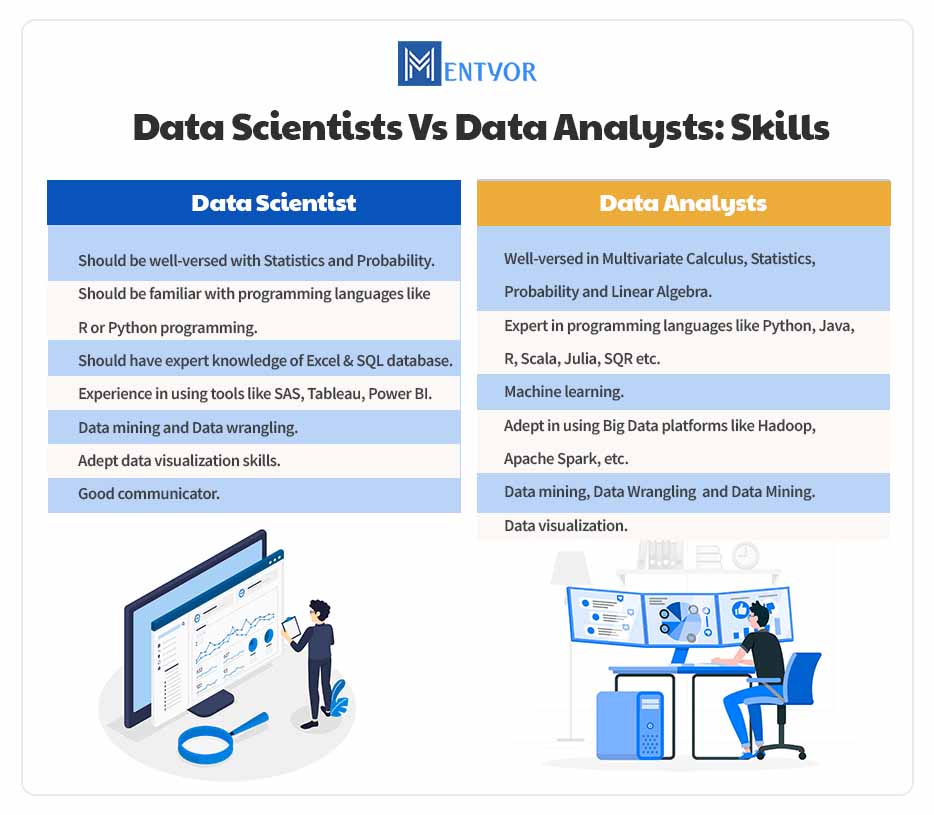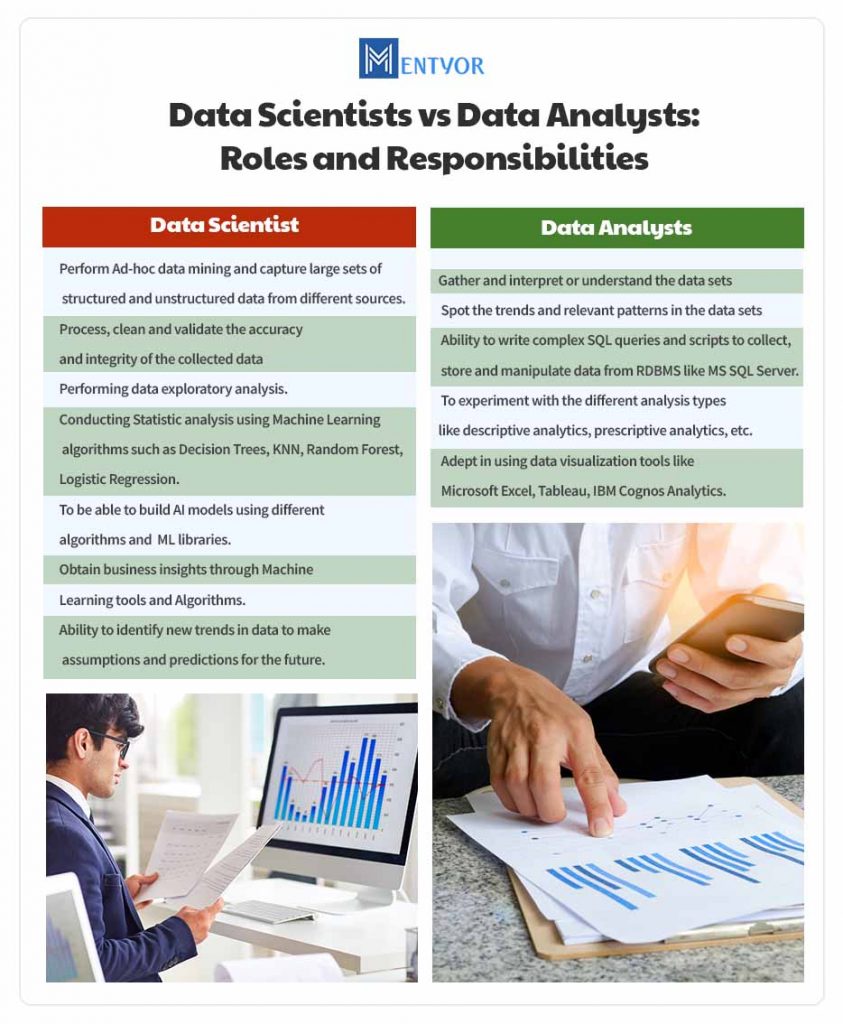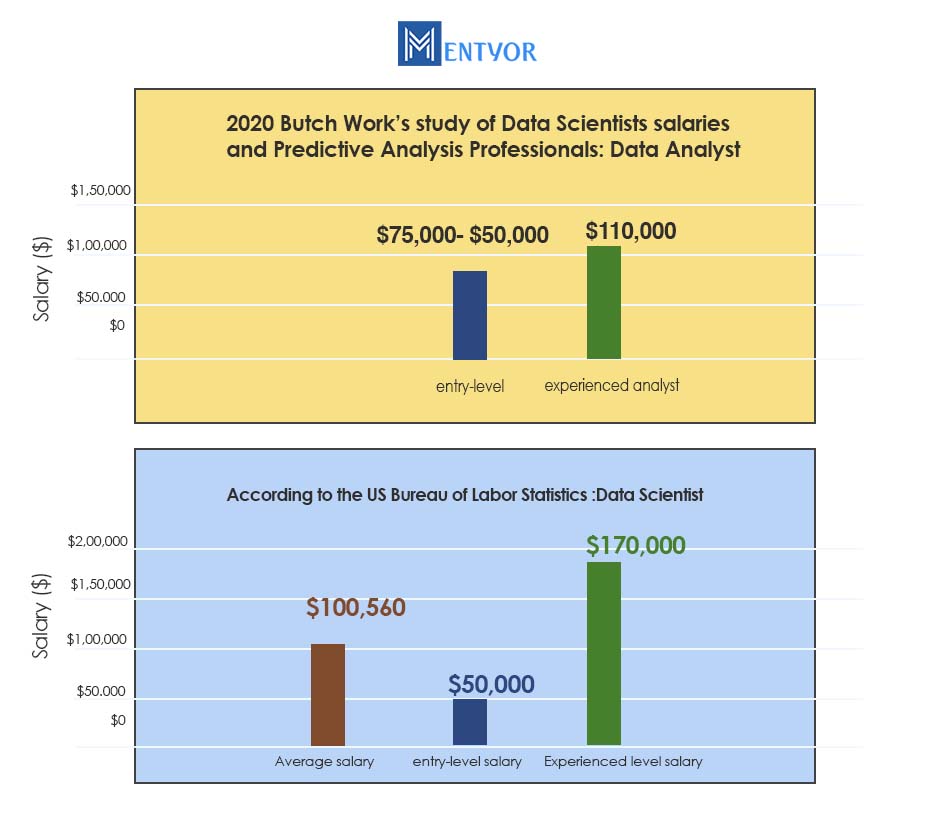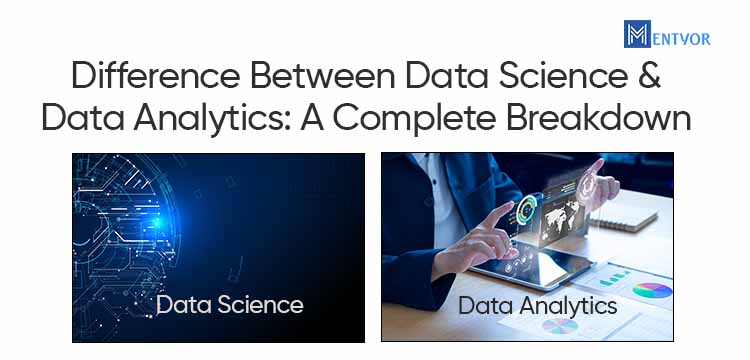The 21st Century is no stranger to the revolution of Big Data. The digital world was already growing by leaps and bounds when covid-19 further pushed people to the digital front. From remote learning to even getting married on zoom meetings, everyone is shifting to the digital landscape. Consequently leaving a ton of online footprints in the form of data. Businesses generate and analyze this data to form more cohesive strategies that can help them fulfil their objectives. As a result, Data Science and Data Analytics has become a field that more and more people are exploring each day.
Read our blog to know Top Reasons why Data Science Jobs are in Demand: Top 9 Reasons Why Data Science Jobs Are In Demand
Data science and data analytics are often used interchangeably, but they are not the same. The difference between data science and data analytics is in their functions.
While data science may be the broader umbrella term, Data Analytics is more of a concise and specific part of Data Science. Although there is a distinct difference between data science and data analytics, both functions still go hand-in-hand. If you’re looking to find a career in either data analysis or data science, then this is the perfect guide for you. Read on as we delve deeper into the details of Data Science and Data analytics and also highlight the key differences between the terms.
What is Data Science?
Data Science is a multidisciplinary method that aims to make sense of the humongous pile of raw data collated daily. It includes an amalgamation of scientific and quantitative methods of Statistics, Engineering, Computer Science, Machine Learning and Artificial Intelligence to name a few. According to Harvard Professor Dustin Tingley, “Data science is a discipline that’s built on a foundation of critical thinking.”[1]
It aims to pose questions through unorganised or organized data sets and also aims to answer them. Through a series of data tools like Hadoop, Spark etc, it aims to build predictive models and shape data.
Data science mainly prioritizes collecting or building the raw data, cleaning it, and then organizing it into various data sets.
What is Data Analytics?
To put it simply, Data Analytics aims to answer the questions put forward by Data Science. While data science aims to collect and build upon raw data, clean it and organize it into various data sets – Data Analysis is used to extract Insights from these organized Data Sets. They seek to explore these data sets and predict implementable models that could help Organisations and businesses fulfil their objectives. Data Analytics is done using a wide range of tools, techniques and methods that differ depending on the type of analysis that is being conducted.
There are four major types of analytics:
- Descriptive Analytics aims to look at the data and describe and understand something that has already happened
- Diagnostic Analytics aims to answer the “why” behind a phenomenon
- Predictive Analytics uses past trends, historical data and strategic assumptions to project what will happen in the future
- Prescriptive Analysis identifies the measurable and well-thought-out steps that an organization or a business must take to reach their future objectives.
Data Science Vs Data Analytics
Although Data Science and Data Analytics both deal with data, the difference between data science and data analytics is in what kind of data they deal with. Data Science is an umbrella term for everything pertaining to Data while Data Analytics has a more specific scope.
Data science acts as the investigator. It mines and cleans data into different sets and begins to pose different questions based on the said data sets. While Data Analysis is the way of answering the questions that data science poses and also finding implementable insights through the datasets found.
Read our Blog about guide to become Data Scientist 2022: How To Become A Data Scientist In 2022: A Complete Guide To Data Science
The main difference between Data science and data analysis can be said that Data analysis focuses more on seeing the historical data and past trends. It uses assumptions to bring out the best possible solutions and future steps for the organization/business. While Data Science is focused more on Machine Learning and Predictive Modelling. The latter focuses on finding the relation between vastly different data sets, while the latter aims to discover the specifics based on the different insights found.
Thus Data Analytics can be said to be a branch of Data Science that focuses more on the post-processing of the data sets found by data science.
Data Scientists vs Data Analysts
Data scientists and Data Analysts both work with Big Data. Data scientists utilize a variety of Complex Mathematical tools like mathematics, Statistics and Machine Learning. They gather structured or unstructured data from many contrasting sources. After collection, this raw data is processed and converted into a format where it could be easily analysed. They clean and validate data to ensure that it is accurate, uniform and complete.
Learn more about Machine Learning: ARTIFICIAL INTELLIGENCE: AN ULTIMATE GUIDE
Data Analysts on the other hand take these large piles of data and explore them to discover implementable insights. These insights can help an organization or a business to fulfil its goals and objectives. They spot trends, make forecasts for the future and gain a better understanding of the collated data. Data analysts are similar to a fusion of Data Scientists and Business Analysts. Once they’ve figured out their findings, they also need to communicate them in the simplest ways possible to both technical and non-technical people. This is why they use various infographics, charts, stories etc to explain their findings.
Now the difference between Data Scientists and Data Analysts may be confusing since essentially they both dabble with data and have inter-connected responsibilities and functions. The major difference is in the tools that Data scientists and data analysts use. Machine learning is a major part of a data scientist day-to-day life while not so much of an analyst’s.
To put it simply, a data analyst’s daily routine consists of daily analysis and providing reports almost every day. And data scientist’s routine consists of designing new ways of storing and manipulating data. The former works on existing data sets while the latter designs the data sets which would later be used by the analysts.
Data Scientists Vs Data Analysts: Skills

The core skills of Data Scientists and Data Analysts mainly differ in the type of tools that they use to conduct their daily responsibilities. While there may be some overlap in their analytics functions, they majorly differ in the quantitative tools section. Data scientists typically use programming languages like Python, R, Java, etc. while data analysts use tools like SQL Database and Excel.
The main skills of a data analyst are:
- Should be well-versed with Statistics and Probability
- Should be familiar with programming languages like R or Python programming
- Should have expert knowledge of Excel and SQL database
- Experience in using tools like SAS, Tableau, Power BI
- Data mining and Data wrangling
- Adept data visualization skills
- Good communicator
The main skills of a Data Scientist include:
- Well-versed in Multivariate Calculus, Statistics, Probability and Linear Algebra
- Expert in programming languages like Python, Java, R, Scala, Julia, SQR etc.
- Machine learning
- Adept in using Big Data platforms like Hadoop, Apache Spark, etc.
- Data mining, Data Wrangling and Data Mining
- Data visualization
The one skill that remains common for both Data Scientists and Data Analysts is Good communication skills. Since at the end of the day, they need to explain their findings to the respective organization or Business, they need to be able to put across their thoughts comprehensively. Both Data Scientists and Data analysts must have brilliant problem-solving skills and an ability to think critically and innovatively.
Data Scientists vs Data Analysts: Roles and Responsibilities
The role of a data scientist or a data analyst’s may change depending on the industry and platform where they work. The job of a data analyst is mostly to look at a data set and answer questions such as “why there was a drop in sales ?” or “which marketing campaign will perform better ?. While Data scientists are more concerned with things that will happen using predictive modelling and big data frameworks like Apache.
Sometimes the job descriptions for A data scientist and a data analyst may overlap in responsibilities. But to understand the difference between data scientists and data analysts, let us look at their roles and responsibilities.

Responsibilities of a Data Scientist:
- Perform Ad-hoc data mining and capture large sets of structured and unstructured data from different sources
- Process, clean and validate the accuracy and integrity of the collected data
- Performing data exploratory analysis
- Conducting Statistic analysis using Machine Learning algorithms such as Decision Trees, KNN, Random Forest, Logistic Regression.
- To be able to build AI models using different algorithms and ML libraries
- Obtain business insights through Machine Learning tools and Algorithms.
- Ability to identify new trends in data to make assumptions and predictions for the future.
Responsibilities of a Data Analyst:
- Gather and interpret or understand the data sets
- Spot the trends and relevant patterns in the data sets
- Ability to write complex SQL queries and scripts to collect, store and manipulate data from RDBMS like MS SQL Server.
- To experiment with the different analysis types like descriptive analytics, prescriptive analytics, etc.
- Adept in using data visualization tools like Microsoft Excel, Tableau, IBM Cognos Analytics.
Data Scientist vs Data Analyst: Educational Requirements
A bachelor’s degree in Mathematics, Statistics, economics or Data Science is imperative to provide a good foundation. There are many MS degrees in Data Science also available to pursue. Many universities also offer a specific specialization in data analysis.
According to a study by Burtch Works Study released in August 2020, 94% of Data scientists who had participated in the study possessed a Master’s or a Doctorate Degree. And around 86% of other Predictive analysis Professionals had a master’s or a doctorate. [2]
Read our blog on Best Data Science Universities in USA: A Guide to 22 Best Data Science Universities in USA
Data Science vs Data Analyst: Salary

According to the US Bureau of Labor Statistics, the average salary of a Data scientist is around $100,560[3]. The median salary of entry-level Data Scientists begins at $50,000. For Experienced Data scientists, the salaries can go as high as $170,000
The 2020 Butch Work’s study of Data Scientists salaries and Predictive Analysis Professionals [2] gives a thorough guideline of the general salaries of Data Science Professionals. For a data analyst, the entry-level salary is around $50,000-$75,000. For an experienced analyst, the pay scale can go up to $110,000.
Data Science Vs Data Analytics: Career Perspective
The skills of a Data Scientist are more technical than a Data Analyst. While the former requires a mathematical approach, data analysts require more of a statistical and analytical approach. The position of a data analyst is most often an entry-level position. While Data scientists already have experience of 5-10 years.
Given the Data Boom in the past couple of years, this industry is only growing. Hence whether a Data Analyst or Data Scientists, you will have plenty of opportunities to scale up.
Frequently Asked Questions
Q1. Is coding required for Data Analytics?
A1. Yes, data analytics does require coding. Analysts are supposed to know coding but advanced skills are not necessary.
Q2. Which is better- data scientist or data analyst?
A2. Both the jobs are essentially in demand. Data Analytics is better suited for individuals with analytical and statistical skills who are just beginning their career in a data science field. While data analytics is a better option for people who are familiar with machine learning.
Q3. Which pays more – data science or data analytics?
A3. Since data scientists are more experienced, they are paid more.
Conclusion
Data Science and Data analytics both are booming industries. According to the World Economic Forum, 463 EB (which is roughly the double amount of Gigabytes) data will be created in the world by 2025.[4] This in itself is enough to substantiate the power data holds in our world.
Data science and Data analytics both have overlapping functions and are interconnected. They are like the two sides of the same coin. Where data scientists explore structure or unstructured datasets to provide relevant questions, data analytics helps to answer them. One cannot be relevant without the other. Hence, both equally serve a purpose towards creating implementable actions through data.
Reference:
[1] Online Data Science Principles Course | HBS Online. (n.d.). Harvard Business School Online. https://online.hbs.edu/courses/data-science-principles/
[2] Butch Works. (2020, August). The Burtch Works Study Salaries of Data Scientists & Predictive Analytics Professionals. https://www.burtchworks.com/wp-content/uploads/2020/08/Burtch-Works-Study_DS-PAP-2020.pdf
[3] Data Scientists and Mathematical Science Occupations, All Other. (2021, September 28). U.S BUREAU OF LABOR STATISTICS. https://www.bls.gov/oes/current/oes152098.htm
[4] How much data is generated each day? (2020, February 8). World Economic Forum. https://www.weforum.org/agenda/2019/04/how-much-data-is-generated-each-day-cf4bddf29f/


 WhatsApp
WhatsApp